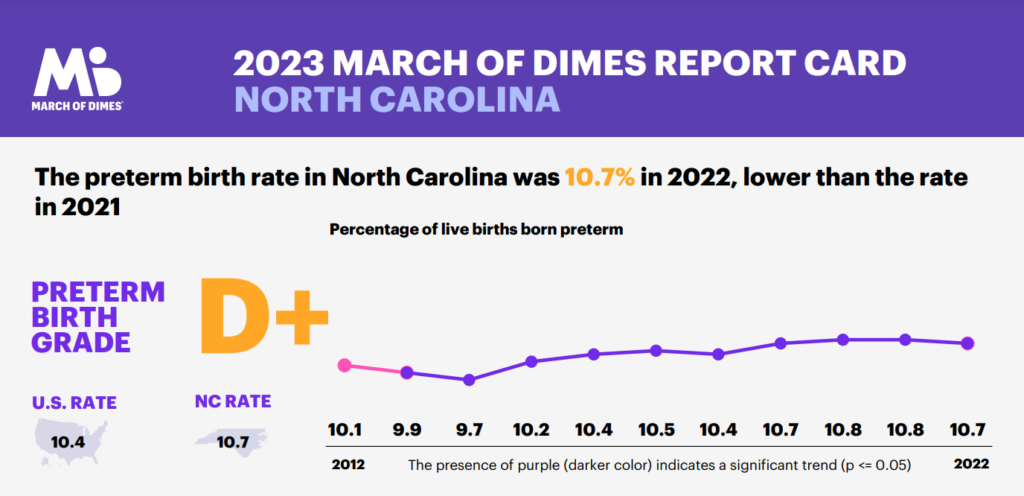Do you ever lay in bed at night and wonder if what you’re doing is helping the community? What we are doing is working!!!!! Our premature birth rate has dropped by 8% in Durham, North Carolina compared to a 1% decrease for North Carolina overall.
In our quest for improved maternal and infant health, the 2023 March of Dimes Report Card offers both a lens into the current state of affairs and a glimmer of hope for communities striving for better outcomes. Among these communities, Durham, North Carolina, emerges as a case study of progress, albeit amidst challenges that continue to underscore the urgent need for systemic change. Premature birth rates dropped by 8% in Durham, North Carolina, while the NC preterm birth rate decreased by 1%.
Durham’s Notable Improvement
The spotlight shines brightly on Durham, with its preterm birth rate marking an improvement, dropping to 9.4% and earning a C+ grade. Last year Durham’s score was 10.2% , earning a C- grade. This contrasts starkly with the broader North Carolina state rate of 10.7% and a national backdrop where disparities in birth outcomes persist. Such data not only highlights Durham’s strides towards healthier births but also ignites a conversation on the effective strategies contributing to this positive trend.
The National Context: A Call for Action
Nationally, the preterm birth rate sits at a concerning 10.4%, with North Carolina slightly above at 10.7%. But this is a 1% improvement for North Carolina from last year. The March of Dimes Report underscores the complexity of maternal and infant health challenges, incorporating critical indicators such as infant mortality, maternal health, and particularly, maternal mortality, a new addition reflecting a deepening commitment to comprehensive health narratives.
The disparities are stark, with the preterm birth rate among babies born to Black birthing people being 1.5 times higher than the rate among all other babies. This discrepancy continues to call for a reflection on the root causes, including systemic racism and socioeconomic factors, but also demands actionable solutions to bridge the health equity gap.
Understanding Durham’s Approach
The improvement in Durham’s preterm birth rate does not happen in a vacuum. It is the result of concerted efforts by local health organizations, community groups, and policymakers, who have focused on addressing the multifaceted challenges of maternal and infant health. Initiatives might range from enhancing access to quality prenatal care, integrating culturally competent health education, to implementing community-based support systems such as doula services. Moreover, recognizing the critical role of social determinants of health, Durham’s strategies likely encompass broader efforts aimed at improving living conditions, education, and economic stability for expecting families.
The Path Forward
The 2023 March of Dimes Report Card serves not only as a mirror reflecting the current state of maternal and infant health but also as a roadmap guiding efforts towards a healthier future. Durham’s progress, though commendable, underscores the journey ahead. It highlights the importance of sustained and comprehensive strategies that address both medical and social determinants of health.
Key policy measures identified by the March of Dimes, including Medicaid extension, doula reimbursement policies, and the establishment of Maternal Mortality Review Committees, present actionable pathways towards equity in maternal and infant health outcomes. Durham’s example offers a glimmer of hope and a testament to the potential impact of dedicated action and community engagement.
In conclusion, as Breastfeed Durham and other stakeholders rally for improved maternal and infant health, the lessons from Durham’s ongoing journey resonate deeply. The community’s progress amidst broader challenges is a clarion call to not only sustain but also amplify efforts to ensure every birthing person and baby has the best start in life. The path to achieving this vision is complex, requiring a multifaceted approach that addresses healthcare access, socio-economic disparities, and systemic inequalities. Yet, with continued commitment and collaboration, a future where every birth is a healthy start is within reach.

